After a long day, the last thing you want is to spend hours in the kitchen. Mediterranean couscous is your perfect solution—quick, easy, and versatile. It cooks in minutes and pairs well with just about anything, making it a go-to for busy nights. In this article, you’ll learn how to make the most of this staple with simple recipes, cooking tips, and insights into its health benefits. Whether you’re new to couscous or looking to elevate your dishes, there’s something here for everyone.
What is Mediterranean Couscous?
History and Origin
Couscous hails from North Africa, where it has been a dietary staple for centuries. It originated with the Berber people in regions like Morocco and Tunisia. Over time, couscous spread across Mediterranean countries and became a beloved part of their cuisine. Today, it’s enjoyed worldwide for its simplicity and versatility.
Types of Couscous
There are three main types of couscous:
- Moroccan Couscous: The smallest and quickest to cook, often used in salads or as a side dish.
- Pearl Couscous: Larger and chewier, perfect for soups and salads.
- Lebanese (Moghrabieh) Couscous: The largest type, used in stews and hearty dishes.
Each type has its own unique texture and works well in different recipes.
Nutritional Benefits
Couscous is low in fat and high in fiber. It’s rich in B vitamins and minerals like iron and selenium, making it a healthy addition to your meals. Plus, it’s low in calories and provides plant-based protein, making it ideal for vegetarian or vegan diets. Couscous is not just easy to make—it’s a nutritious base for a variety of dishes.
How to Cook Perfect Mediterranean Couscous
Basic Cooking Instructions
Cooking couscous is straightforward, but getting it just right can make all the difference. Here’s a simple step-by-step guide:
- Measure the Couscous and Liquid: Use a 1:1 ratio of couscous to water or broth. For example, 1 cup of couscous needs 1 cup of liquid.
- Boil the Liquid: Bring the water or broth to a boil in a medium saucepan. Add a pinch of salt and a drizzle of olive oil for extra flavor.
- Add the Couscous: Once the liquid is boiling, remove the saucepan from heat, stir in the couscous, and cover it with a lid.
- Let It Sit: Allow the couscous to steam for about 5 minutes, during which it absorbs the liquid and cooks.
- Fluff with a Fork: After steaming, use a fork to fluff the couscous, breaking up any clumps and making it light and airy.
Flavor Enhancements
Take your couscous to the next level with these simple flavor-boosting techniques:
- Toast the Couscous: Lightly toast the dry couscous in olive oil over medium heat for a few minutes until it turns golden brown, enhancing its nutty flavor.
- Use Broth Instead of Water: Cooking couscous in chicken, vegetable, or beef broth adds depth and richness to the dish.
- Add Aromatics: Toss in a bay leaf, garlic, or a sprig of thyme to the boiling liquid for added flavor.
- Mix in Fresh Herbs: After cooking, stir in chopped fresh herbs like parsley, cilantro, or mint for a burst of freshness.
Common Mistakes to Avoid
Even though couscous is easy to prepare, a few common mistakes can affect the final result:
- Overcooking: Leaving couscous in the liquid for too long can make it mushy. Stick to the 5-minute rule and fluff immediately.
- Under-seasoning: Couscous can be bland if not seasoned properly. Don’t forget to add salt to the cooking liquid and taste before serving.
- Not Fluffing: Skipping the fluffing step can lead to clumpy, dense couscous. Always fluff with a fork to ensure a light texture.
By following these steps and tips, you’ll achieve perfectly cooked, flavorful couscous every time, ready to complement any Mediterranean dish.
Popular Mediterranean Couscous Recipes
Classic Mediterranean Couscous Salad
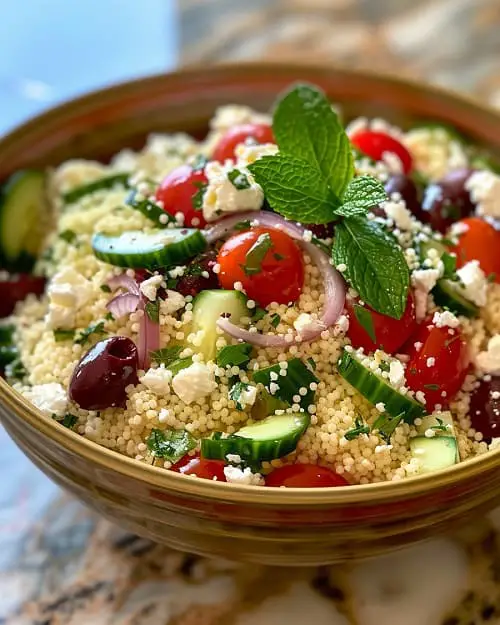
This classic Mediterranean couscous salad is a refreshing and flavorful dish, perfect for a light lunch or as a side at dinner.
Ingredients:
- 1 cup Moroccan couscous, cooked and cooled
- 1 cucumber, diced
- 1 cup cherry tomatoes, halved
- 1/2 red onion, finely chopped
- 1/2 cup pitted Kalamata olives, sliced
- 1/2 cup feta cheese, crumbled
- Fresh parsley and mint, chopped
Lemon Vinaigrette:
- Juice of 1 lemon
- 1/4 cup extra-virgin olive oil
- 1 garlic clove, minced
- Salt and pepper to taste
Instructions:
- Prepare the Couscous: Cook the couscous according to the package instructions. Once done, fluff it with a fork and let it cool.
- Mix the Salad: In a large bowl, combine the cucumber, tomatoes, red onion, olives, and herbs. Add the cooled couscous and mix well.
- Make the Dressing: In a small bowl, whisk together the lemon juice, olive oil, garlic, salt, and pepper.
- Combine: Pour the vinaigrette over the salad and toss everything together. Sprinkle with crumbled feta cheese before serving.
Tips: This salad is highly customizable. Add roasted red peppers, artichoke hearts, or switch out the feta for goat cheese. It’s great for meal prep as the flavors deepen when stored in the fridge.
Mediterranean Couscous Bowls
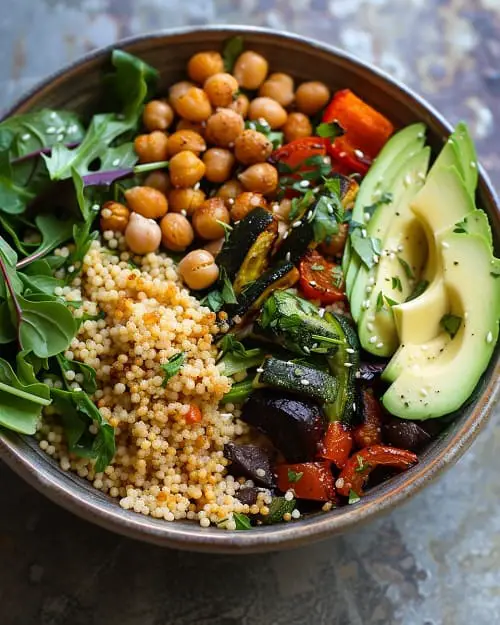
For a hearty, filling meal, these Mediterranean couscous bowls are packed with flavor and nutrients.
Ingredients:
- 1 cup pearl couscous, cooked and cooled
- 1 can chickpeas, drained and rinsed
- 1 cup roasted seasonal vegetables (like zucchini, bell peppers, or eggplant)
- 1/2 avocado, sliced
- 2 tbsp tahini sauce
- Fresh spinach or arugula
Instructions:
- Cook the Couscous: Prepare the Israeli couscous according to package instructions. Let it cool after fluffing with a fork.
- Assemble the Bowl: In a large bowl, layer the spinach or arugula, then add a scoop of couscous, chickpeas, and roasted vegetables.
- Add the Toppings: Top with avocado slices and drizzle with tahini sauce.
- Serve: This bowl is perfect as-is, or you can add a sprinkle of sesame seeds or a squeeze of lemon for extra flavor.
Tips: Switch up the vegetables based on what’s in season. Roasted sweet potatoes or cauliflower make great additions.
Seafood Couscous
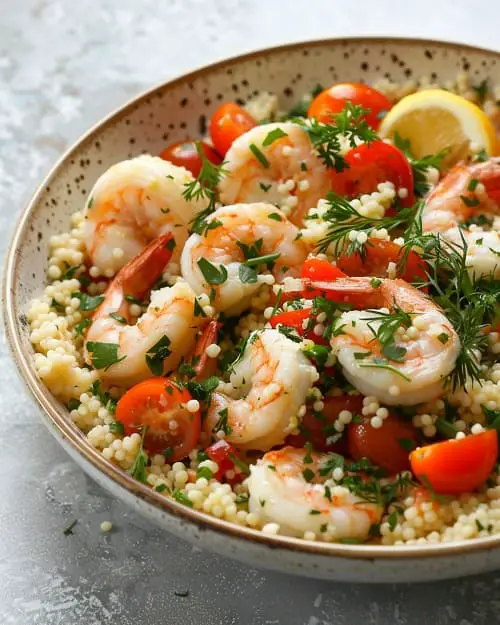
Bring the flavors of the Mediterranean coast to your kitchen with this seafood couscous recipe.
Ingredients:
- 1 cup Lebanese couscous (Moghrabieh)
- 1/2 lb shrimp, peeled and deveined
- 1/2 lb calamari, cleaned and sliced into rings
- 2 garlic cloves, minced
- 1/2 cup cherry tomatoes, halved
- Fresh dill and parsley, chopped
- 1 lemon, zested and juiced
Instructions:
- Cook the Couscous: Lebanese couscous takes longer to cook. Simmer it in salted water or broth until tender, then drain and set aside.
- Sauté the Seafood: In a large skillet, heat olive oil over medium heat. Add the garlic and sauté for a minute before adding the shrimp and calamari. Cook until the seafood is just done.
- Combine: Add the cooked couscous to the skillet along with the tomatoes. Toss everything together with fresh herbs and lemon juice.
- Serve: Garnish with lemon zest and more fresh herbs before serving.
Tips: For extra depth, try adding a splash of white wine to the pan while cooking the seafood. You can also swap the calamari for scallops or mussels if you prefer.
Vegetarian/Vegan Options
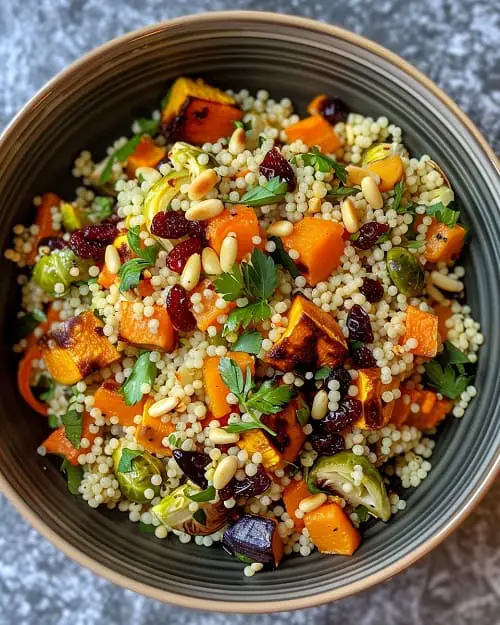
Couscous is a fantastic base for plant-based dishes, pairing well with roasted vegetables, nuts, and fresh herbs.
Ingredients:
- 1 cup Moroccan couscous, cooked and cooled
- 1 cup roasted vegetables (e.g., butternut squash, Brussels sprouts, red onion)
- 1/4 cup toasted pine nuts
- 1/4 cup dried cranberries or raisins
- Fresh basil and cilantro, chopped
Instructions:
- Prepare the Couscous: Cook the couscous and let it cool, fluffing with a fork.
- Mix the Salad: In a large bowl, combine the couscous with the roasted vegetables, pine nuts, dried cranberries, and herbs.
- Dress: Drizzle with olive oil and a splash of balsamic vinegar, then toss to combine.
- Serve: This dish is great served warm or cold.
Tips: Add protein with cooked lentils or chickpeas. For a nut-free option, substitute the pine nuts with sunflower seeds.
Health Benefits of Mediterranean Couscous
Dietary Advantages
Couscous is a perfect fit for those following the Mediterranean diet, emphasizing whole grains, lean proteins, and plenty of vegetables. Made from semolina wheat, couscous is a light and fluffy alternative to heavier grains like rice or pasta. Its quick cooking time makes it an excellent option for busy individuals seeking a nutritious meal without the wait.
Couscous is low in fat and calories while providing a satisfying and filling base for meals. It’s versatile, absorbing the flavors of whatever it’s cooked with, making it easy to integrate into various dishes, from salads to main courses.
Comparative Nutritional Analysis
When compared to other grains and pastas, couscous offers some unique nutritional benefits:
- Lower Glycemic Index: Couscous has a lower glycemic index than white rice and many pastas, meaning it causes a slower rise in blood sugar levels. This makes it a better option for those managing their blood sugar, like people with diabetes.
- Higher Fiber Content: Whole wheat couscous is higher in fiber than traditional pasta, aiding digestion and keeping you fuller longer. Fiber is also essential for heart health, making couscous a heart-healthy choice.
- Rich in Selenium: Couscous is a good source of selenium, a mineral crucial for maintaining a healthy immune system and supporting thyroid function. It’s also an antioxidant, helping to protect your cells from damage.
Overall, couscous stands out for its balanced nutritional profile, providing a good mix of carbs, protein, and fiber, with fewer calories than many other grain-based foods.
Incorporating Couscous into a Balanced Diet
Incorporating couscous into your daily diet is simple and rewarding. Here are some tips:
- Pair with Lean Proteins: Add grilled chicken, fish, or legumes to your couscous for a balanced meal. The protein helps keep you full and supports muscle repair and growth.
- Load Up on Vegetables: Couscous is a great base for adding various vegetables. Roasted vegetables like bell peppers, zucchini, and tomatoes not only add color but also increase the fiber and vitamin content of your meal.
- Use it in Salads: Couscous makes a great addition to salads. Mix it with leafy greens, cucumbers, and a light vinaigrette for a refreshing, nutrient-packed dish.
- Try Different Flavors: Experiment with spices and herbs like cumin, coriander, and mint to give your couscous a flavor boost without extra calories. Using flavored broths instead of water for cooking can also add depth to the dish.
FAQs
What is couscous made of?
Couscous is made from semolina wheat, the hard part of the grain left after milling. It’s formed into tiny granules that are steamed or cooked in liquid to create a light, fluffy texture.
Is couscous gluten-free?
No, couscous is not gluten-free as it is made from wheat. However, gluten-free alternatives are available, such as quinoa or rice couscous.
How do I store cooked couscous?
Cooked couscous can be stored in an airtight container in the refrigerator for up to four days. It’s great for meal prep, as you can make a large batch and use it throughout the week.
Can I eat couscous cold?
Yes, couscous can be eaten cold, making it a perfect ingredient for salads. Mix it with vegetables, herbs, and a light dressing for a refreshing meal.
Is couscous healthy?
Yes, couscous is healthy. It’s low in fat and calories while being a good source of fiber, protein, and essential nutrients like B vitamins and selenium. It’s also a versatile base that can be paired with various vegetables and lean proteins for a balanced meal.
Can I use couscous as a substitute for rice?
Absolutely! Couscous can be used as a substitute for rice in many dishes. It cooks faster and has a lighter texture, making it a great alternative in stir-fries, salads, and bowls.
Conclusion
Couscous is a versatile and nutritious ingredient that fits seamlessly into various dishes, whether you’re whipping up a quick weeknight meal or preparing a flavorful Mediterranean feast. Its ease of preparation, combined with its light texture and ability to absorb flavors, makes it a favorite in kitchens worldwide.
Whether you’re trying a classic Mediterranean couscous salad, experimenting with a hearty couscous bowl, or exploring seafood options, couscous offers endless possibilities for delicious and healthy meals. It’s especially valuable for those following the Mediterranean diet, which emphasizes whole grains, vegetables, and lean proteins.
Give couscous a try in your next meal—whether it’s lunch, or dinner. Experiment with different types and flavors, and don’t hesitate to share your creations or tips in the comments. If you enjoyed this article, follow the blog for more recipes, cooking tips, and nutritional insights. Happy cooking!
PrintMediterranean Couscous: Recipes, Benefits, and Tips
- Total Time: 25 minutes
- Yield: 4 servings
- Diet: Vegetarian
Description
A refreshing Mediterranean couscous salad featuring fluffy Moroccan couscous, vibrant fresh vegetables, tangy Kalamata olives, and creamy feta cheese. Tossed in a zesty lemon vinaigrette, this salad is perfect as a light lunch, dinner side, or meal prep option. Bursting with flavor and easy to customize, it’s a crowd-pleaser for any occasion.
Ingredients
Salad
• 1 cup Moroccan couscous, cooked and cooled
• 1 cucumber, diced
• 1 cup cherry tomatoes, halved
• 1/2 red onion, finely chopped
• 1/2 cup pitted Kalamata olives, sliced
• 1/2 cup feta cheese, crumbled
• Fresh parsley and mint, chopped
Lemon Vinaigrette
• Juice of 1 lemon
• 1/4 cup extra-virgin olive oil
• 1 garlic clove, minced
• Salt and pepper to taste
Instructions
- Cook the Couscous: Follow package instructions for the Moroccan couscous. Once cooked, fluff with a fork and let it cool to room temperature.
- Prepare the Vegetables: Dice the cucumber, halve the cherry tomatoes, and finely chop the red onion. Slice the Kalamata olives and chop the fresh parsley and mint.
- Combine Ingredients: In a large bowl, mix the cooled couscous with the prepared vegetables, olives, and herbs.
- Make the Dressing: Whisk together lemon juice, olive oil, minced garlic, salt, and pepper in a small bowl. Adjust seasoning to taste.
- Toss and Serve: Pour the dressing over the couscous salad and toss gently until well combined. Sprinkle crumbled feta cheese on top before serving.
Notes
- Customizations: Add roasted red peppers, artichoke hearts, or switch feta with goat cheese for a twist.
- Storage Tip: Store leftovers in an airtight container in the refrigerator for up to 3 days. Flavors deepen as it sits!
- Serving Suggestion: Pair with grilled chicken, fish, or a hearty soup for a complete meal.
- Make Ahead: Cook couscous and chop vegetables ahead of time. Assemble and dress just before serving.
- Prep Time: 10 minutes
- Cook Time: 15 minutes
- Category: Salad, Side Dish
- Method: No-cook (after couscous is prepared)
- Cuisine: Mediterranean
Nutrition
- Serving Size: 1 cup
- Calories: ~220 kcal
- Sugar: 4 g
- Sodium: 350 mg
- Fat: 12g
- Saturated Fat: 3g
- Unsaturated Fat: 9 g
- Trans Fat: 0g
- Carbohydrates: 24 g
- Fiber: 3g
- Protein: 6g
- Cholesterol: 10 mg
Keywords: Mediterranean couscous salad, couscous recipes, vegetarian salad, quick and easy Mediterranean dishes

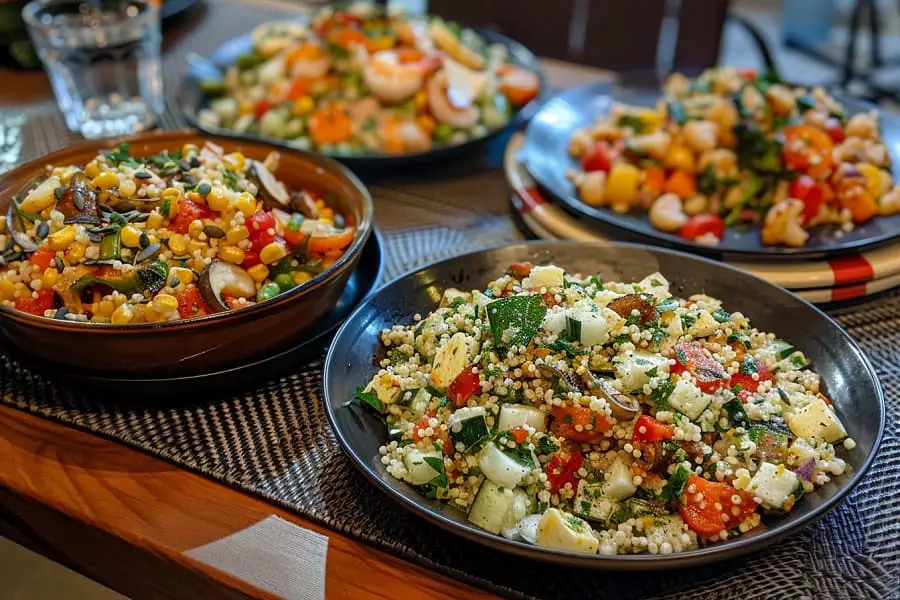
1 thought on “Mediterranean Couscous: Recipes, Benefits, and Tips”